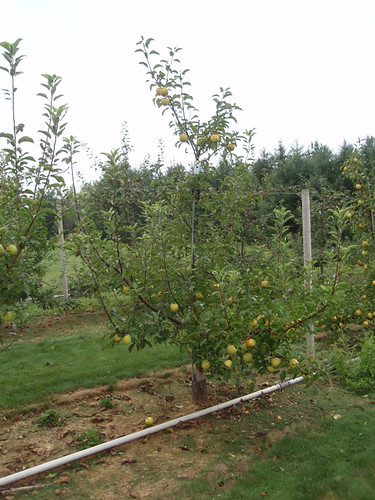Strong wind, especially wind associated with tropical storms that saturate the soil, can cause fruit trees to lean and sometimes be totally uprooted. Due to small and brittle root systems, dwarfing rootstocks tend to be prone to wind damage.
Susceptibility to wind damage appears to be related to the combination of rootstock and scion cultivar. Some brittle cultivars, such as ‘Gala’ and ‘Golden Delicious’, when propagated on brittle rootstocks, such as G.30 or M.26, may snap at the bud union. Trees on dwarf rootstocks cannot support the weight of a large crop and should not be grown without support. In commercial orchards, dwarf trees are typically well supported and wind damage is rarely a problem unless the support system is inadequate. Semi-dwarfing rootstocks usually do not require support under normal circumstances but may lean during severe wind events. Trees on the semi-dwarfing rootstock M.7 are prone to leaning when combined with certain vigorous cultivars; M.7 trees with ‘McIntosh’, ‘Empire’ and spur-type ‘Delicious’ strains rarely have leaning problems, but severe leaning has been observed with cultivars such as ‘Granny Smith’, ‘Stayman’, ‘Gala’, ‘Golden Delicious’, and non-spur-type strains of ‘Delicious’.
Tree leaning may be nearly eliminated by providing trunk support with a stake to a height of at least 4 feet above ground. If leaning occurs, trees should be up-righted as soon as possible and stabilized with a stake.
| Rootstock break after wind storm. Photo: Emily Hoover, University of Minnesota. | ‘Golden Delicious’ on M.26, staked. Photo: Robert Crassweller, Penn State University. |
|---|---|
 |
 |
Rich Marini, Penn State University
